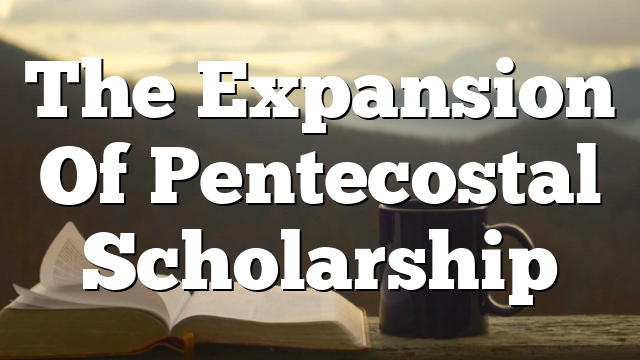Click to join the conversation with over 500,000 Pentecostal believers and scholars
Click to get our FREE MOBILE APP and stay connected
| PentecostalTheology.com



PNEUMA 38 (2016) 245–248
The Expansion of Pentecostal Scholarship
The expansion of pentecostal scholarship means that Pentecostals are mov- ing beyond the synchronic focus on the particularity of historical origins and doctrines and also beyond the focus on the diachronic relationship with other Christian traditions, faiths, and academic disciplines. In other words, pente- costal scholarship needs not only to focus on denominational distinctives and issues, pentecostal and otherwise, but also to expand into theological discus- sions such as pneumatology, Christology, and biblical studies, and into theo- retical discourses in the social sciences, physical sciences, and comparative religion. Many who would not identify as pentecostal, however defined, or even confessionally Christian, have a disciplinary interest in Pentecostalism for rea- sons related to their field of study. This diversity brings up a range of questions that are contested by society members and includes insider/outsider debates, ecumenical and interfaith concerns, theological disciplines broadly construed, and the place of other academic disciplines in discussions on Pentecostalism. Some scholars, such as Gerald T. Sheppard, have argued that there is no such thing as pentecostal theology per se, but that Pentecostals must fit into and engage the larger theological and scientific categories. His concern was that a narrow focus on pentecostal theology that refused to address broader issues would lead to insular sectarianism. Others contend that pentecostal theology from a pentecostal perspective is a legitimate sub-discipline, and they have set about elaborating on what theology conducted from a pentecostal perspective would look like. Often times these scholars engage non-theological disciplines in an effort to discern their implications for pentecostal and theological dis- courses. Notwithstanding Sheppard’s concern about sectarianism, the latter approach engages the wider theological traditions as well as other scholarly perspectives such as the faith and science debates.
With this diversity in mind, the articles in this issue include a wide range of interests. The first article, by Christian T. Collins Winn, explores the Anglo- American reception of German Pietists Johann Christoph Blumhardt and his son, Christoph Friedrich Blumhardt. The Blumhardts are considered proto- Pentecostals by many and fully pentecostal by others, such as Jürgen Molt- mann,1 depending on how Pentecostalism is defined. The elder Blumhardt’s
1 Jürgen Moltmann, Foreword toSpirit of the Last Days: Pentecostal Eschatology in Conversation
with Jürgen Moltmann, by Peter Althouse (London: T & T Clark International, 2003), vii–ix.
© koninklijke brill nv, leiden, 2016 | doi: 10.1163/15700747-03803012
1
246
althouse and waddell
pentecostal ministry began with a case of demonic possession and prayer for deliverance, followed by a healing ministry that he interpreted as the in- breaking of the kingdom. This eschatological interpretation of healing saw the fulfilment of the kingdom in the outpouring of the Spirit defined as a cosmic Pentecost. The younger Blumhardt took his father’s healing message in a social direction that believed that the in-breaking of the kingdom was evident in the struggles for social justice. Winn describes three phases in which the Blumhardts were received by the Anglo-American, English-speaking world: the early phase in the nineteenth century was primarily interested in Johann Blumhardt’s healing ministry; the second phase began in the mid-twentieth century with the publication of primary sources in English and of important secondary sources in an effort to plumb the Blumhardts’ theology as resources for theological construction; and the third phase, which is currently ongoing, continues to translate the Blumhardt corpus into English and place these works within a critical, scholarly framework. The reception of the Blumhardts in English is significant, argues Winn, because diverse Christian traditions, including Pentecostalism, have appropriated the Blumhardts’ focus on piety and justice. They are able to offer a holistic understanding of ministry and healing in a pastoral, nonsystematic manner, but as intellectually credible thinkers. Their reception into the English world offers ways in which theology can potentially integrate a rich spirituality and expectation of healing with a concern for social justice. They are also able to unite those who hold to the uniqueness of Christ with discernment about how God may be working through other faith communities.
In the next article Tanya Riches employs Nimi Wariboko’s three-city model to assess Australian Pentecostalism’s worship rituals. Specifically, the Charis- matic City copes with change through adaptation. Riches employs the Charis- matic City to explain the rhizomatic (or decentralized) networks in the global flows of cultural homogenization and fragmentation. Sacred space is increas- ingly translocal and without place or location in the context of globalization, in which there are flows of people, media, technology, capital, and ideas. Riches uses two case studies to test the Charismatic City model. One is Sydney’s Hill- song Church, whose lyrical worship reveals a diminution of pneumatologi- cal language and pentecostal distinctiveness and an increase in christological themes. The other case observes Aboriginal Australian pentecostal congrega- tions that demonstrate a counterflow in which the indigenous ritual of “yarn- ing,” an informal and relaxed mode of conversation, is incorporated into their worship. The particularity of indigenous cultural practices is incorporated into the global flows of Pentecostalism.
Ekaputra Tupamahu offers a postcolonial analysis of colonial language and the implication this has for the pentecostal practice of glossolalia. Specifically,
PNEUMA 38 (2016) 245–248
2
the expansion of pentecostal scholarship
247
Tupamahu articulates a view of glossolalia as resistance to the global domi- nance of colonial language. Critically drawing on the work of David Crystal, Robert Phillipson, and Michel Foucault, among others, Tupamahu argues that English gained dominance as a colonial language through different regimes of legal jurisprudence, educational “disciplinary power,” and finally through the internalization of the superiority of the dominant language over indigenous languages. Tupamahu contends that empire cannot be viewed as a central- ized, unidirectional power, but as decentralized and multidirectional. Conse- quently, resistance to empire must be multidirectional, or what Foucault calls “plurality of resistances.” Here is where Tupamahu places the significance of tongues speech. Glossolalia is a strategic disruption of the regimes of language that signifies resistance to domination. Drawing on Roman Jakobson’s theory of language disorder and Judith Butler’s theory of performance, Tupamahu concludes that glossolalia does not constitute language in any normal sense, but voluntarily subverts the rules of language through repetitive performance. Speaking in tongues represents the disruption of language discourse, includ- ing theological discourse, so that the power structures of colonialism are sub- verted.
Andrea Shan Johnson works to sort out the messy historiography and con- troversy surrounding a man named Sykes, who is peripherally connected to the Arroyo Seco, California camp meeting where the Jesus’ Name baptism controversy was sparked. During the camp meeting, Canadian R.E. McAlister preached a sermon in which he pondered the difference between the apostles’ use of the name of Jesus Christ in water baptism and the Gospel’s use of the titles Father, Son, and Holy Ghost. According to the story told by early One- ness Pentecostal Frank Ewart, a man by the name of Frank Denny approached the platform and told McAlister not to promote this doctrine, because it was associated with a “Dr. Sykes.” Through the use of archival resources, however, Johnson argues that the history is muddled in popular accounts and that the person referred to was not Dr. Melvin E. Sykes, who was active in the First African Methodist Episcopal Church, but likely Baptist minister Joshua Sykes, who was known to baptize converts in the name of Christ. Joshua Sykes was a controversial figure who adopted many pentecostal-like characteristics, such as the promotion of visions, speaking in tongues, end-time prophecies, and mira- cles. Some of the more controversial practices included opposition to marriage, having church members turn over property and savings, and pacifism, the last of which eventually resulted in legal battles and eventual incarceration in the context of the Great War.
Joel Travis Hamme provides a comparative analysis of the ancient Near Eastern prayers and their implications for pentecostal prayer practices. These prayers of lament were used for healing and reconciliation because alienation
PNEUMA 38 (2016) 245–248
3
248
althouse and waddell
from personal deities was believed to be the cause of disruption in relation- ships as well as of mental and physical illness. In both ancient Mesopotamia and Palestine, penitential prayers had similar purpose, form, and structure. Hamme argues that attention to cultural contextualization could help rein- tegrate lament into the life of the church and the spirituality and worship of Pentecostalism. The Mesopotamian prayerdingir.ša.dib.bailī ul idêand the Hebrew Psalms 38 and 58 are similar in their use of medical and protection pleas against illness, enemy attack, and community ostracism. Ritual use of these prayers was thought to bring reconciliation to one’s personal gods and eliminatethecauseofillness.Theywerealsousedtorestoreonetopurityandas a confession of sin. Hamme argues that the contextualized appropriation of the psalms can be found in the African Initiated Churches (aic), where the African context is culturally closer to the ancient Near East than to the West’s concern for new knowledge. Theaichave appropriated the psalms for community for- mation and ritual use. Penitential psalms mesh well with the African cultural world with rituals of healing, protection, purity, and reconciliation. Hamme fur- ther argues that rather than viewing these rites as a form of magical invocation, as some scholars have suggested, theaicuse these psalms in a way that is con- sistent with the culture of ancient Israel, whose worldview is strikingly similar to the African worldview.
The range of discussion in this issue is consistent with the expansion of pen- tecostal scholarship. Interest in historical, theological, and ancient literature, as well as in postcolonialism and globalization, bears witness to the growing diversity of scholarly concerns.
Peter Althouse and Robby Waddell
PNEUMA 38 (2016) 245–248
4


